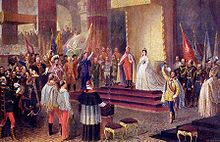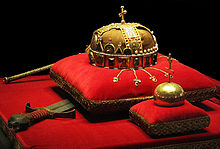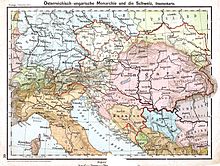Apostolic King of Hungary
Apostolic King of Hungary ( Hungarian apostoli magyar király ) was from 1000 to 1918 and de jure from 1920 to 1946 the title of head of state of the Kingdom of Hungary with its lands and possessions . The bearers came from several dynasties (including in the final phase from the House of Habsburg-Lothringen ).
history

The Hungarian royal title originated with the coronation of the previous Hungarian Grand Duke Stephen I as King of Hungary in 1000 (according to other sources 1001) after he converted to Christianity . 1758 awarded Pope Clement XIII. the title addition apostolic .
The first bearers of the royal dignity came from the House of Árpád . Some short-lived dynasties followed, such as the Czech Přemyslids , the Bavarian Wittelsbachers , the French house Anjou , the German house Luxembourg , briefly the Polish Jagiellonians and, with the coronation of Ferdinand I in 1524, the House of Habsburg .
The dynasty represented the kings of Hungary largely constant until 1918. However, their rule was always uncertain; Over the centuries there were repeated uprisings and revolutions against the ruling house, not least of which had the denominational contrast between the Catholic Habsburgs and the largely Calvinist petty nobility as a background. In addition, from 1541 the country was divided for centuries by Austria and the Ottoman Empire , which only ended after the Great Turkish War with the Peace of Karlowitz in 1699. At the same time, a rule that was independent of the Habsburgs was established in Transylvania , the Grand Duchy of Transylvania , whose princes formally gave up their claim to all of Hungary in 1570, but repeatedly supported anti-Habsburg uprisings militarily. The Turkish wars devastated and depopulated entire regions.
The Habsburgs were only able to cope with the aversion of the Hungarians with the coronation of the Emperor of Austria and King of Bohemia Franz Joseph I (Hungarian I. Ferenc József ) on June 8, 1867, with the so-called Austro-Hungarian Compromise and the establishment of the constitutional hereditary monarchy Austria-Hungary were completed, counteract this. The mood changed fundamentally in the wake of economic improvements during industrialization . The Magyars also remained loyal to Franz Joseph I's successor, Charles I (as King Charles IV, Hungarian IV Károly ), who was crowned the last king on December 30, 1916, and fought side by side with the other peoples of the Habsburg Empire until the 1918 defeat in World War I for their king.
The Hungarian kingship actually expired with the dissolution of Austria-Hungary on October 31, 1918, theoretically only with the declaration of renunciation by King Charles IV on November 13, 1918. However, the monarch did not formally abdicate and raised claims to the until his death in 1922 hungarian crown. In 1921 the Hungarian parliament banned the Habsburgs from the royal throne and the country retained the monarchy without a king until the Republic of Hungary was proclaimed in 1946.
Bearer of the title
Symbols and characteristics of royalty


The three most important symbols of the Hungarian royal title were the three coronation insignia: the crown of St. Stephen , the imperial orb and the scepter . The crown has been a Hungarian national symbol and part of the Hungarian coat of arms since 1867, but actually held this position before.
The acceptance of the royal dignity was connected with the swearing of the oath of allegiance to the crown and later an oath on the Hungarian constitution.
The King of Hungary was first elected by the Hungarian nobility. In 1687 the Hungarian state parliament declared the Hungarian crown hereditary and demanded more rights from the Habsburgs.
The royal residences or places of coronation of the Hungarian monarchs were in medieval times Székesfehérvár (Hungarian Székesfehérvár ), the time of the Habsburg monarchy Pressburg (Hungarian Pozsony , Slovak Prešporok , since 1919, Bratislava ) today and from 1867 Budapest . From this point on, the monarch resided in the castle palace , where he carried out the official duties of the Hungarian half of Austria-Hungary for several weeks a year in Hungarian clothing and language . However, his influence in the Hungarian half of the empire remained significantly less than in the Austrian (Austrian Empire ), which was evident in the case of unrealized reforms such as electoral law or the federalization of Hungary.
The king of Hungary was at the time of Austria-Hungary officially in personal union King of Croatia-Slavonia , Grand Prince of Transylvania and Großwojwode the Wojwodschaft Serbia .

